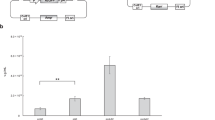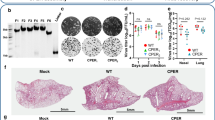Abstract
The capacity to modify the reovirus genome facilitates generation of new therapeutic reoviruses. We describe a method for generating replication-competent reoviruses carrying a heterologous transgene. The strategy is based on the expanded-tropism reovirus mutant jin-3, which can infect cells independent of the reovirus receptor junction-adhesion molecule A (JAM-A). Jin-3 harbors a mutation in the S1 segment, resulting in a G196R substitution in the tail of the spike protein σ1. The use of the jin-3 tail-encoding S1 segment allows replacing the codons for the JAM-A-binding head domain by up to 522 nucleotides of foreign sequences, without exceeding the size of the wild-type S1 segment. We inserted the codons for the porcine teschovirus-1 2A element fused with those encoding the fluorescent protein iLOV. Replicating rS1His-2A-iLOV reoviruses were generated by co-transfection of expression plasmids for all reovirus segments. These reoviruses contain the S1His-2A-iLOV segment in the absence of the wild-type S1 segment. Density-gradient centrifugation confirmed the association of the σ1-tail fragment with the capsid. Both JAM-A-positive and -negative cells exposed to the rS1His-2A-iLOV reoviruses exhibited iLOV fluorescence, confirming the jin-3-derived expanded-tropism phenotype. These data demonstrated the feasibility of generating decapitated replication-competent T3D reoviruses carrying a heterologous transgene.
This is a preview of subscription content, access via your institution
Access options
Subscribe to this journal
Receive 12 print issues and online access
$259.00 per year
only $21.58 per issue
Buy this article
- Purchase on Springer Link
- Instant access to full article PDF
Prices may be subject to local taxes which are calculated during checkout








Similar content being viewed by others
Accession codes
References
Marcato P, Shmulevitz M, Pan D, Stoltz D, Lee PWK . Ras transformation mediates reovirus oncolysis by enhancing virus uncoating, particle infectivity, and apoptosis-dependent release. Mol Ther 2007; 15: 1522–1530.
Smakman N, Van Den Wollenberg DJM, Borel Rinkes IHM, Hoeben RC, Kranenburg O . Sensitization to apoptosis underlies KrasD12-dependent oncolysis of murine C26 colorectal carcinoma cells by reovirus T3D. J Virol 2005; 79: 14981–14985.
Tyler KL, Squier MK, Rodgers SE, Schneider BE, Oberhaus SM, Grdina TA et al. Differences in the capacity of reovirus strains to induce apoptosis are determined by the viral attachment protein sigma 1. J Virol 1995; 69: 6972–6979.
Tyler KL, Squier MK, Brown AL, Pike B, Willis D, Oberhaus SM et al. Linkage between reovirus-induced apoptosis and inhibition of cellular DNA synthesis: role of the S1 and M2 genes. J Virol 1996; 70: 7984–7991.
Kyula JN, Roulstone V, Karapanagiotou EM, Melcher AA, Harrington KJ . Oncolytic reovirus type 3 (Dearing) as a novel therapy in head and neck cancer. Expert Opin Biol Ther 2012; 12: 1669–1678.
Harrington KJ, Vile RG, Melcher A, Chester J, Pandha HS . Clinical trials with oncolytic reovirus: moving beyond phase I into combinations with standard therapeutics. Cytokine Growth Factor Rev 2010; 21: 91–98.
Kobayashi T, Antar AA, Boehme KW, Danthi P, Eby EA, Guglielmi KM et al. A plasmid-based reverse genetics system for animal double-stranded RNA viruses. Cell Host Microbes 2007; 1: 147–157.
Van Den Wollenberg DJM, Van Den Hengel SK, Dautzenberg IJC, Cramer SJ, Kranenburg O, Hoeben RC . A strategy for genetic modification of the spike-encoding segment of human reovirus T3D for reovirus targeting. Gene Therapy 2008; 15: 1567–15678.
Demidenko AA, Blattman JN, Blattman NN, Greenberg PD, Nibert ML . Engineering recombinant reoviruses with tandem repeats and a tetravirus 2A-like element for exogenous polypeptide expression. Proc Natl Acad Sci USA 2013; 110: 1867–1876.
Brochu-Lafontaine V, Lemay G . Addition of exogenous polypeptides on the mammalian reovirus outer capsid using reverse genetics. J Virol Methods 2012; 179: 342–350.
Roner MR, Joklik WK . Reovirus reverse genetics: incorporation of the CAT gene into the reovirus genome. Proc Natl Acad Sci USA 2001; 98: 8036–8041.
Van Den Wollenberg DJ, Dautzenberg IJ, Van Den Hengel SK, Cramer SJ, De Groot RJ, Hoeben RC . Isolation of reovirus T3D mutants capable of infecting human tumor cells independent of junction adhesion molecule-A. PLoS One 2012; 7: e48064.
Dautzenberg IJ, Van Den Wollenberg DJ, Van Den Hengel SK, Limpens RW, Barcena M, Koster AJ et al. Mammalian orthoreovirus T3D infects U-118 MG cell spheroids independent of junction adhesion molecule-A. Gene Therapy 2014; 21: 609–617.
Barton ES, Connolly JL, Forrest JC, Chappell JD, Dermody TS . Utilization of sialic acid as a coreceptor enhances reovirus attachment by multistep adhesion strengthening. J Biol Chem 2001; 276: 2200–2211.
Reiter DM, Frierson JM, Halvorson EE, Kobayashi T, Dermody TS, Stehle T . Crystal structure of reovirus attachment protein -s1 in complex with sialylated oligosaccharides. PLoS Pathogen 2011; 7: e1002166–e1002166.
Dermody TS, Nibert ML, Bassel-Duby R, Fields BN . Sequence diversity in S1 genes and S1 translation products of 11 serotype 3 reovirus strains. J. Virol 1990; 64: 4842–4850.
Hoyt CC, Richardson-Burns SM, Goody RJ, Robinson BA, DeBiasi RL, Tyler KL . Nonstructural Protein σ1s Is a Determinant of Reovirus Virulence and Influences the Kinetics and Severity of Apoptosis Induction in the Heart and Central Nervous System. J Virol 2005; 79: 2743–2753.
Poggioli GJ, Keefer C, Connolly JL, Dermody TS, Tyler KL . Reovirus-induced G2/M cell cycle arrest requires ς1s and occurs in the absence of apoptosis. J. Virol 2000; 74: 9562–9570.
Boehme KW, Hammer K, Tollefson WC, Konopka-Anstadt JL, Kobayashi T, Dermody TS . Nonstructural protein sigma1s mediates reovirus-induced cell cycle arrest and apoptosis. J Virol 2013; 87: 12967–12979.
Chapman S, Faulkner C, Kaiserli E, Garcia-Mata C, Savenkov EI, Roberts AG et al. The photoreversible fluorescent protein iLOV outperforms GFP as a reporter of plant virus infection. Proc Natl Acad Sci USA 2008; 105: 20038–20043.
Leone G, Maybaum L, Lee PW . The reovirus cell attachment protein possesses two independently active trimerization domains: basis of dominant negative effects. Cell 1992; 71: 479–488.
Chappell JD, Barton ES, Smith TH, Baer GS, Duong DT, Nibert ML et al. Cleavage susceptibility of reovirus attachment protein sigma1 during proteolytic disassembly of virions is determined by a sequence polymorphism in the sigma1 neck. J Virol 1998; 72: 8205–8213.
Alain T, Kim TS, Lun X, Liacini A, Schiff LA, Senger DL et al. Proteolytic disassembly is a critical determinant for reovirus oncolysis. Mol Ther 2007; 15: 1512–1521.
Roner MR, Roehr J . The 3' sequences required for incorporation of an engineered ssRNA into the reovirus genome. Virol J 2006; 3: 1–11.
Kobayashi T, Ooms LS, Ikizler M, Chappell JD, Dermody TS . An improved reverse genetics system for mammalian orthoreoviruses. Virology 2010; 398: 194–200.
Connolly JL, Barton ES, Dermody TS . Reovirus binding to cell surface sialic acid potentiates virus-induced apoptosis. J Virol 2001; 75: 4029–4039.
Deutscher SL, Nuwayhid N, Stanley P, Briles EIB, Hirschberg CB . Translocation across golgi vesicle membranes: a CHO glycosylation mutant deficient in CMP-sialic acid transport. Cell 1984; 39: 295–299.
Kim JH, Lee S-R, Li L-H, Park H-J, Park J-H, Lee KY et al. High cleavage efficiency of a 2A peptide derived from porcine teschovirus-1 in human cell lines, zebrafish and mice. PLoS One 2011; 6: e18556.
Szymczak-Workman AL, Vignali KM, Vignali DA . Design and construction of 2A peptide-linked multicistronic vectors. Cold Spring Harb Protoc 2012; 2012: 199–204.
Kim M, Garant KA, zur Nieden NI, Alain T, Loken SD, Urbanski SJ et al. Attenuated reovirus displays oncolysis with reduced host toxicity. Br J Cancer 2011; 104: 290–299.
Chappell JD, Gunn VL, Wetzel JD, Baer GS, Dermody TS . Mutations in type 3 reovirus that determine binding to sialic acid are contained in the fibrous tail domain of viral attachment protein sigma1. J Virol 1997; 71: 1834–1841.
Chappell JD, Duong JL, Wright BW, Dermody TS . Identification of carbohydrate-binding domains in the attachment proteins of type 1 and type 3 reoviruses. J Virol 2000; 74: 8472–8479.
Seago J, Juleff N, Moffat K, Berryman S, Christie JM, Charleston B et al. An infectious recombinant foot-and-mouth disease virus expressing a fluorescent marker protein. J Gen Virol 2013; 94: 1517–1527.
Christie JM, Hitomi K, Arvai AS, Hartfield KA, Mettlen M, Pratt AJ et al. Structural tuning of the fluorescent protein iLOV for improved photostability. J Biol Chem 2012; 287: 22295–22304.
Zou S, Brown EG . Identification of sequence elements containing signals for replication and encapsidation of the reovirus M1 genome segment. Virology 1992; 186: 377–388.
Bodelon G, Labrada L, Martinez-Costas J, Benavente J . The avian reovirus genome segment S1 is a functionally tricistronic gene that expresses one structural and two nonstructural proteins in infected cells. Virology 2001; 290: 181–191.
Ni Y, Kemp MC . Subgenomic S1 segments are packaged by avian reovirus defective interfering particles having an S1 segment deletion. Virus Res 1994; 32: 329–342.
Fallaux FJ, Kranenburg O, Cramer SJ, Houweling A, van Ormondt H, Hoeben RC et al. Characterization of 911: a new helper cell line for the titration and propagation of early region 1-deleted adenoviral vectors. Hum Gene Ther 1996; 7: 215–222.
Buchholz UJ, Finke S, Conzelmann KK . Generation of bovine respiratory syncytial virus (BRSV) from cDNA: BRSV NS2 is not essential for virus replication in tissue culture, and the human RSV leader region acts as a functional BRSV genome promoter. J Virol 1999; 73: 251–259.
Klein B, Pastink A, Odijk H, Westerveld A, van der Eb AJ . Transformation and immortalization of diploid xeroderma pigmentosum fibroblasts. Exp Cell Res 1990; 191: 256–262.
Roner MR, Steele BG . Features of the mammalian orthoreovirus 3 Dearing l1 single-stranded RNA that direct packaging and serotype restriction. J Gen Virol 2007; 88: 3401–3412.
Boehme KW, Ikizler M, Kobayashi T, Dermody TS . Reverse genetics for mammalian reovirus. Methods 2011; 55: 109–113.
Transfiguracion J, Bernier A, Voyer R, Coelho H, Coffey M, Kamen A . Rapid and reliable quantification of reovirus type 3 by high performance liquid chromatography during manufacturing of Reolysin. J Pharm Biomed Anal 2008; 48: 598–605.
Virgin HW, Mann MA, Fields BN, Tyler KL . Monoclonal antibodies to reovirus reveal structure/function relationships between capsid proteins and genetics of susceptibility to antibody action. J Virol 1991; 65: 6772–6781.
Navarro A, Trask SD, Patton JT . Generation of genetically stable recombinant rotaviruses containing novel genome rearrangements and heterologous sequences by reverse genetics. J Virol 2013; 87: 6211–6220.
Reed LJ, Muench H . A simple method of estimating fifty per cent endpoints. Am J Epidemiol 1938; 27: 493–497.
Acknowledgements
We thank Dr Danijela Koppers-Lalic and Leithe Buedel for helpful discussions and suggestions. Aitor Navarro is gratefully acknowledged for providing us the protocol for RNA electrophoresis and helpful comments.
Author information
Authors and Affiliations
Corresponding author
Ethics declarations
Competing interests
The authors declare no conflict of interest.
Rights and permissions
About this article
Cite this article
van den Wollenberg, D., Dautzenberg, I., Ros, W. et al. Replicating reoviruses with a transgene replacing the codons for the head domain of the viral spike. Gene Ther 22, 267–279 (2015). https://doi.org/10.1038/gt.2014.126
Received:
Revised:
Accepted:
Published:
Issue Date:
DOI: https://doi.org/10.1038/gt.2014.126
This article is cited by
-
Infectious recombinant Senecavirus A expressing novel reporter proteins
Applied Microbiology and Biotechnology (2021)
-
Arming oncolytic reovirus with GM-CSF gene to enhance immunity
Cancer Gene Therapy (2019)
-
A natural reassortant and mutant serotype 3 reovirus from mink in China
Archives of Virology (2016)



